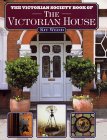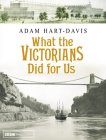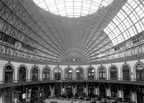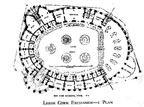House of Hanover cont.
Victoria 1837 1901


- If you enjoyed the BBC2 series What the Victorians Did for Us narrated by: Adam Hart Davis. Then read his book.

A great read for anyone who likes to dabble in history.
1837 - 8
- Victoria Bridge, Leeds built
1838
- Whilst the Leeds Parish Church tower was being demolished a few stone crosses from the 9/10th-century were found, presumably belonging to the earlier church.
- The hey day of coaching with 130 coaches a day leaving Leeds.
1838 40
- Temple Mill Leeds built in the style of an Egyptian Temple by John Marshall in Marshall Street Holbeck, Leeds
1839
- The Leeds and Manchester 51 mile railway line was opened in 1839, Chief Engineer: George Stephenson overcame problems such as the 1 mile, 1,125 yard long Summit Tunnel.
1841
- New Leeds Parish Church built.
1842
- Leeds Clean water supplies provided. Leeds Slum clearance undertaken.
- Leeds Crown Point bridge completed.
1846
- Leeds Central Station opened for the Leeds and Bradford Railway Company.
- The first real synagoge in Leeds, a converted house in Rockinham Street, now the Merrion Centre.
1847
- Armley Jail Leeds built.
1849
- A more serious outbreak of Cholera killing 2000.
1850s
- Leeds Council starts to build sewers.
1851
- The population of Leeds has more than tripled in the last 50 years to 172,270.
1852
- Leeds Central Station taken over by the Midland Railway Company.
- Competition to build the Town Hall held in 1852, which was designed won, and built by Cuthbert Brodrick .
1853 8
- The impressive Leeds Town Hall built of Millstone grit
1854 - 55
Crimea war.
1857
- The Town Hall tower and dome was still being built when the hall was opened.
1858
- The Town Hall opened by Queen Victoria. The impressive Town Hall organ, built by Gray and Davidson in the central great hall being named Victoria Hall.
1859
- The over 6 foot diameter bell weighing over 4 tons installed in the Town Hall Tower.
- The first purpose synagoge in Belgrave Street Leeds.
1863


- The Corn Exchange is completed. One of Britain's finest Victorian buildings. The architect was Cuthbert Brodrick
- He also designed:
- Leeds Town Hall 1858.
- The Mechanics' Institute, 1860 (becomming the Civic Theatre and now the Leeds City Museum).
- The Oriental Baths in Cookridge Street, swimming pool & turkish bathes, 1866 (demolished)
- Headingley Hill Congregational Church, 1864.
- The Brodrick Building, Cookridge St, Leeds, now popworld bar
1864
The only public execution at Armley Jail.
1864
Tower Works built in Globe Road with 2 magnificent chimneys, which still dominate the skyline of. The smaller steam chimney based on the Verona Lamberti Tower, the larger dust extraction chimney based on the Florence Giotto Campanile.
1864 69
The General Infirmary built in Great George Street, design by Sir George Gilbert Scott in a medieval gothic style, contributions to the design layout of wards by Florence Nightingale.
1864
The acts of 1864 and 1875 made it illegate to use "climbing boys" to sweep chimneys.
1865
The Victoria Hotel built.
1865 8
- The Coliseum Theatre, built then the Coliseum Cinema, the Gaumont Cinema 1938, the Creation nightclub now the O2 Academy.
- The Mechanics Institute built. Now the Civic Theatre and college of Music. Another building by Cuthbert Brodrick.
1866 9
- The New Station (Now Leeds City Station) built next to City Square. Built on a series of arches the Dark Arches, now part of Granary Walk, and over the River Aire. See River side Walk .
- The railway viaduct built running Eastwards almost alongside, Sovereign Street, The calls (part) and Call Lane splitting the town into two.
1867
- The Lions installed in front of the Town Hall.
- Theatre Royal built in 1771 demolished
1868
- The 3rd White cloth Hall is demolished. Replaced by the 4th. Later replaced by the Hotel Metropole now called The Met.
1869
- The old stone Leeds Bridge is removed. The new iron one opening in 1873.
1870
- Educational provisions started.
1871
- The first Theatre Royal was built in Lands Lane
- A horse drawn tramway system constructed. Trams continued in Leeds long after they were discontinued in other Cities.
1872
- Roundhay Park purchased for £139,000 by Leeds City Council in 1872 opened to the public.
- At the time the purchase was regarded as a waste of tax payers money, due to it's distance 4 miles from the smoky town centre.
1873
- The opening of the wrought and cast iron Leeds Bridge designed by Thomas Dyne Steele and built by John Butler Iron Works in Stanningly. This bridge replaced a several arched stone bridge, removed in 1869.
1876
- The Grand Theatre and Opera House opens.
1885
- City Varieties built.
1867
The New Theatre Royal built
1868
- Most of Boar Lane remodeled.
1874
- Yorkshire College of Science founded in Leeds, later becoming Leeds University.
1876
The Leeds Theatre Royal in Lands Lane opens.
1876
- Provender Mill built in The Calls selling foodstuff for horses. Now The Chandleres flats. Note the horse's head over the old archway.
1878
- Thornton's Arcade built
1879
- The opening of the current Leeds Bridge House, the wedge shaped building between The Adelphi pub and The Old Red Lion Pub. Originally opened as the Cobdent Temperance Hotel.
1881
- Mr Gladstone the Prime minister visits Leeds.
1884
- Michael Marks of Marks and Spencer's fame opened his first Penny Bazaar, a stall in Leeds Market.
- Municipal Buildings opened to house Civic departments, Police and Central Library. Designer: George Corson.
1888
- The worlds 1st successful moving picture was made of horses crossing the bridge, by Louis Le Prince.
- City Art Gallery opened.
1889
- The Rose and crown demolished for the building of Queens Arcade.
1890
- Joshua Tetley buys his first pub the Duke William in Bowman Lane. The pub now closed is within the brewery grounds. The Brewery demolished 2012.
1891 4
- School of Medicine built in Thoresby Place.
- St Aidan's church. Harehills built. Contains an imposing 1,000 square foot mosaic. The mosaic was designed in 1909, finished 1916.
1893
The Leeds Electric Lighting Works opened.
1893
- Leeds is a commercial success and City charter granted by Queen Victoria giving Leeds a City status.
1894
- The Yorkshire Penny Bank erected on the site of the original Leeds General Infirmary in Infirmary Street..
- Electric trams start to replace horse drawn ones.
- Michael Marks opened a market stall in Leeds Market and formed a partnership with Tom Spencer thus founding Marks and Spencer's, now the largest European shop chain.
1898
Grand and Victoria Arcades built1899
- The Hotel Metropole now called The Met was opened on the site of the 4th White Cloth Hall
1899 1902
- Boer War in South Africa
20th-century
- The main industries are now Engineering and Tailoring
- During this century these industries would diminish and services industries, banking, financial, insurance and National Health industries take over. The City council becomes a very large employer.
- Towards the end of the century Leeds becomes a tourist attraction.
1900
- Leeds prospered as the woolen trade grew, nevertheless it was never a town wholly reliant on wool.
- By 1900, Leeds boasted a varied economic base and alternative forms of employment were made available by its flourishing commercial activities.
- The ready made clothing and textile industry, then pioneered by off the peg clothing manufacturers such as Montague Burton, operated successfully alongside the printing and engineering industries.
- John Waddington became the world’s biggest playing card and games manufacturer including the world famouse game of Monopoly.
- Clarke, Fowler and Kitson ran the biggest engineering works in Yorkshire.
- Leeds never experienced the mass depression suffered by many single industry towns.
History Pages Menu
Monarchs Early - 1216
Edward the Confessor Harold II. William I (the Conqueror). William II . Henry I . Stephen. Matilda. Henry II. Richard I the Lionheart. John
Major Events
Viking, Roman and Saxon Eras
Battle of Stanford Bridge 1066
Battle of Hastings 1066
Magna Carta 1215.
Monarchs 1216 - 1471
Henry III. Edward I. II. III. Richard II. Henry IV. V. VI
Monarchs
House Of York
Edward IV. V. Richard III.
House Of Tudor
Henry VII. VIII. Edward VI. Lady Jane Grey. Mary I. Elizabeth I the Virgin Queen.
House of Stuart
House of Orange
William III of Orange
House of Hanover
George I, George II, George III, George IV, William IV, Victoria
House of Saxe-Coburg-Gotha
Edward VII
House of Winsor (Change of Name from German to British
George V, Edward VIII Abdicated to marry Wallis Simpson. George VI, Elizabeth II
Major Events
The Armarda 1588. & the Golden Years
Oliver Cromwell Lord Protector. Richard Cromwell. Charles II. Mary II. William III. Anne. George I
The republic
George II. III. IV. William IV
Victoria
Crimean War 1854 56. Boer War 1899 - 1902
Edward VII. George V. Edward VIII
1stWorld War 1914-1918
George VI
2ndWorld War 1939 - 1945
Falklands War 1982.
Gulf War on January 9 1996.
Gulf War II week one March 19. 2003.



